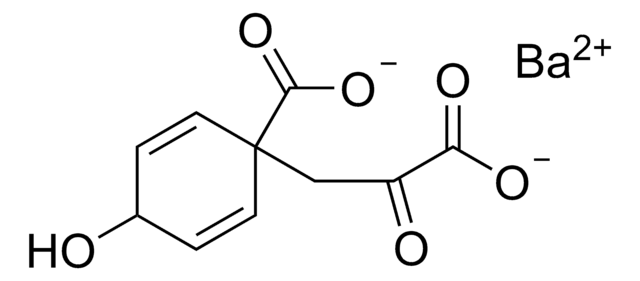114286
4-Hydroxyphenylpyruvic acid
98%
Sinónimos:
3-(4-Hydroxyphenyl)-2-oxopropanoic acid
About This Item
Productos recomendados
Ensayo
98%
Formulario
solid
mp
219-220 °C (dec.) (lit.)
solubilidad
ethanol: soluble 50 mg/mL
grupo funcional
carboxylic acid
ketone
cadena SMILES
OC(=O)C(=O)Cc1ccc(O)cc1
InChI
1S/C9H8O4/c10-7-3-1-6(2-4-7)5-8(11)9(12)13/h1-4,10H,5H2,(H,12,13)
Clave InChI
KKADPXVIOXHVKN-UHFFFAOYSA-N
¿Está buscando productos similares? Visita Guía de comparación de productos
Categorías relacionadas
Descripción general
Aplicación
<li><strong>Identification of serum biomarkers of ischemic stroke:</strong>4-Hydroxyphenylpyruvic acid is used as a potential diagnostic biomarker in the study to distinguish hypertensive ischemic stroke (IS) patients from both healthy individuals and those with hypertension (Zhao et al., 2023).</li>
</ul>
Nota de preparación
Palabra de señalización
Warning
Frases de peligro
Consejos de prudencia
Clasificaciones de peligro
Eye Irrit. 2 - Skin Irrit. 2
Código de clase de almacenamiento
11 - Combustible Solids
Clase de riesgo para el agua (WGK)
WGK 3
Punto de inflamabilidad (°F)
Not applicable
Punto de inflamabilidad (°C)
Not applicable
Equipo de protección personal
dust mask type N95 (US), Eyeshields, Gloves
Elija entre una de las versiones más recientes:
¿Ya tiene este producto?
Encuentre la documentación para los productos que ha comprado recientemente en la Biblioteca de documentos.
Los clientes también vieron
Nuestro equipo de científicos tiene experiencia en todas las áreas de investigación: Ciencias de la vida, Ciencia de los materiales, Síntesis química, Cromatografía, Analítica y muchas otras.
Póngase en contacto con el Servicio técnico









